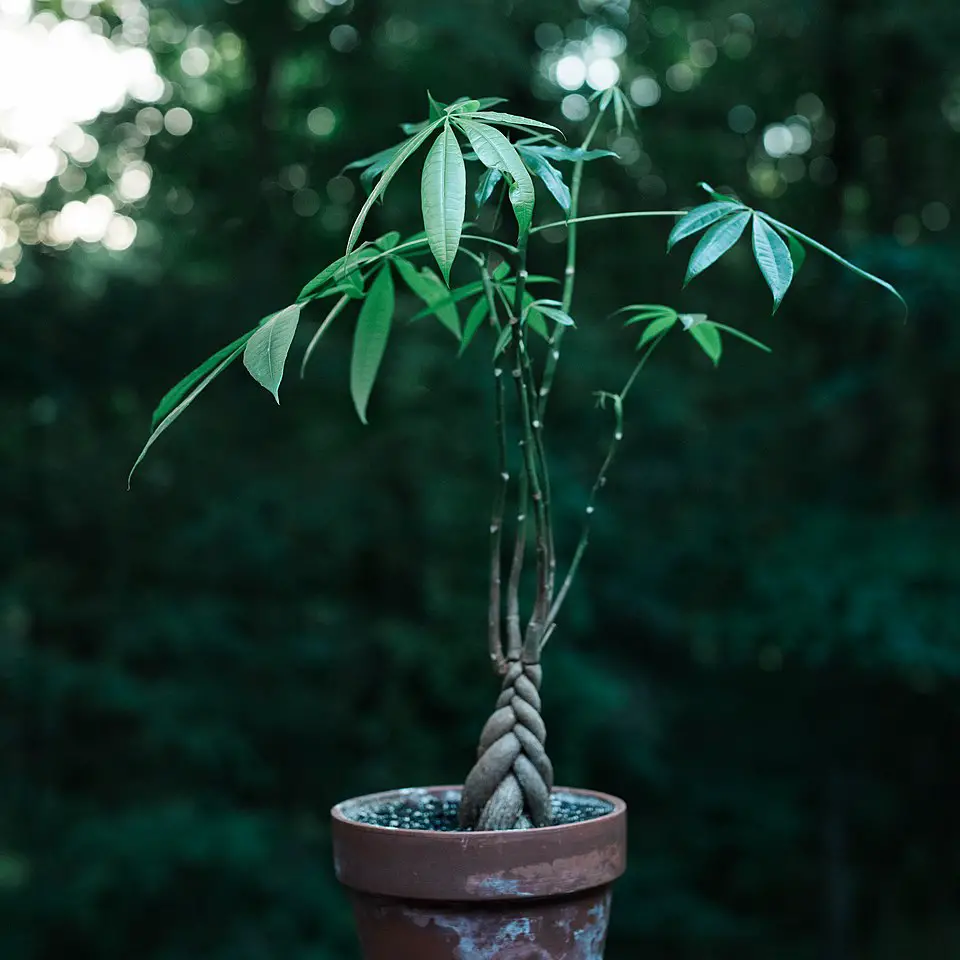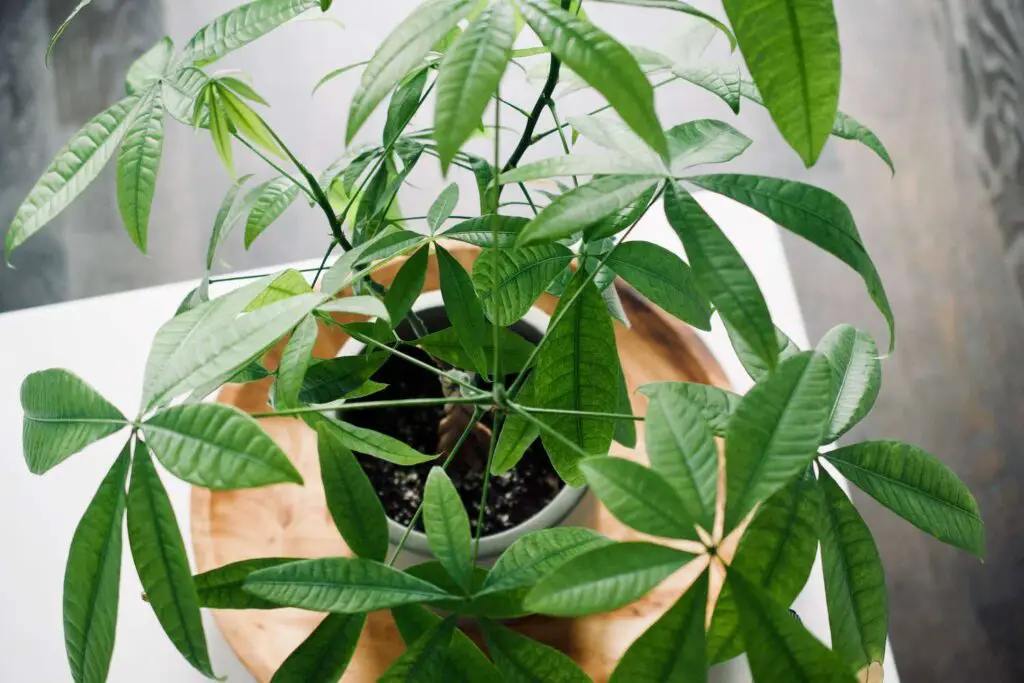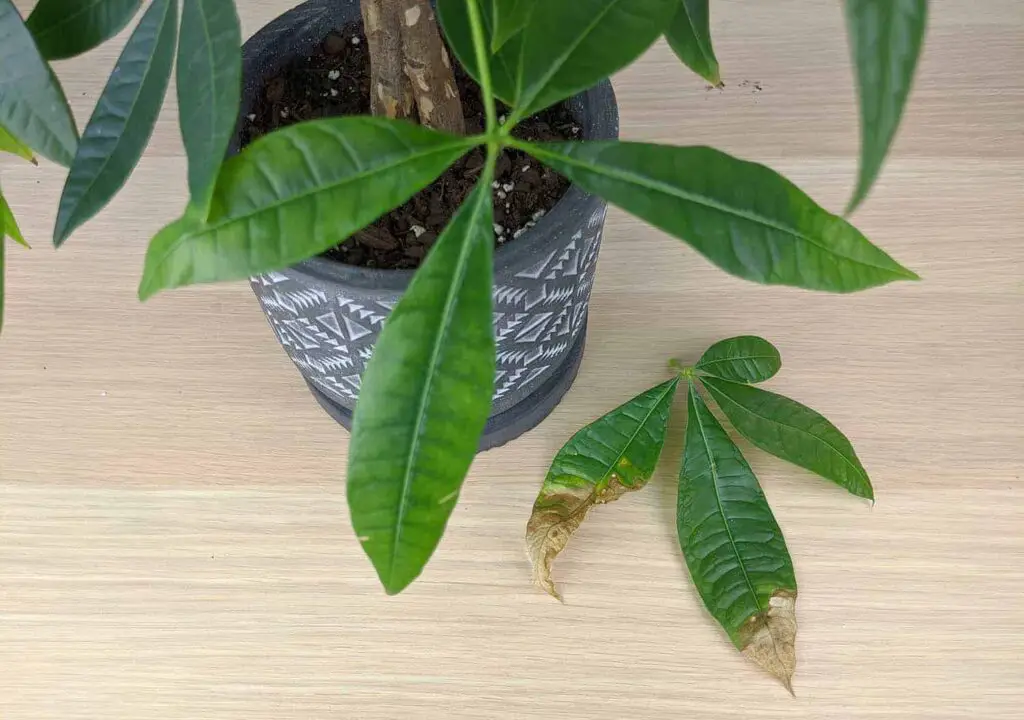A full-grown Money Tree, known scientifically as Pachira aquatica, can reach heights of up to 60 feet in the wild. These trees thrive in tropical regions, primarily in Central and South America, and are often associated with good luck and prosperity due to their unique braided trunks and lush foliage.
Understanding the Money Tree
The Money Tree is a popular houseplant, but its origins lie in the wild. These trees are native to wetland areas in Central and South America. They typically grow near rivers and in swampy regions, where their roots can absorb moisture and nutrients effectively. In their natural habitat, Money Trees can achieve impressive heights and spread, showcasing their ability to adapt to various environmental conditions.

The Money Tree’s name is derived from its association with prosperity and good fortune. According to folklore, if you place a Money Tree in your home or office, it is believed to attract wealth and positive energy. This belief has contributed to its popularity as a decorative plant around the world.
Physical Characteristics
A full-grown Money Tree exhibits several fascinating physical features. The most notable is its trunk, which often has a braided appearance. This is achieved by intertwining several young plants together as they grow. The braided trunk symbolizes strength and resilience.
In addition to its distinctive trunk, the Money Tree has large, palmate leaves that can grow up to 12 inches long. These leaves are usually bright green and can have a glossy finish, making them visually appealing. The tree produces yellow or white flowers and can bear fruit, although this is rare in cultivated specimens.

Habitat and Growth Conditions
Money Trees flourish in tropical climates where temperatures remain warm throughout the year. They prefer well-draining soil that is rich in organic matter. In the wild, these trees can tolerate varying levels of sunlight, though they generally thrive in partial shade. Their adaptability allows them to grow in different environments, from wet riverbanks to drier areas.
| Characteristic | Description |
|---|---|
| Height | Up to 60 feet in the wild |
| Leaves | Palmate leaves up to 12 inches long |
| Trunk | Often braided with a strong structure |
| Flowers | Yellow or white flowers (rarely seen in cultivation) |
| Fruit | Can bear fruit, though uncommon in cultivated plants |
Cultural Significance
The cultural significance of the Money Tree goes beyond its aesthetic appeal. In many Asian cultures, it symbolizes prosperity and good fortune. It is often given as a gift during special occasions such as weddings or housewarmings. In Feng Shui practices, the Money Tree is believed to attract positive energy and enhance wealth.
Moreover, the tree’s ability to purify the air further adds to its value as a houseplant. Studies have shown that plants like the Money Tree can help improve indoor air quality by filtering toxins and releasing oxygen.

Growing Money Trees in the Wild
In their natural environment, Money Trees play a crucial role in maintaining the ecosystem. They provide habitat for various species of wildlife and contribute to soil stability along riverbanks. Their roots help prevent erosion, making them an essential part of the wetlands where they thrive.
While cultivating a Money Tree indoors is common, understanding its wild counterparts offers insights into how these trees contribute to their ecosystems. As urbanization continues to encroach on natural habitats, efforts to preserve these majestic trees and their environments become increasingly important.
Ecological Importance of Money Trees
The ecological importance of Money Trees extends beyond their individual characteristics. These trees play a vital role in their natural habitats. As part of the ecosystem, they contribute to biodiversity and support various forms of wildlife.
Money Trees provide food and shelter for many animals. Birds, insects, and other wildlife depend on these trees for survival. The flowers attract pollinators, while the leaves and fruits offer nourishment.

Habitat for Wildlife
In their native habitats, Money Trees create a unique environment that supports a range of species. Here are some examples of wildlife that may inhabit areas where Money Trees grow:
- Birds: Many birds are attracted to the flowers for nectar and the fruits for food.
- Insects: Pollinators such as bees and butterflies are essential for the reproduction of Money Trees, as they help with the pollination process.
- Small Mammals: Rodents and other small mammals may use the trees for cover and food sources.
- Reptiles: Some reptiles seek shelter in the branches or among the roots of Money Trees.
Soil Preservation and Erosion Control
Money Trees are also crucial for soil preservation. Their extensive root system stabilizes the soil, preventing erosion along riverbanks and in wetland areas. This is especially important in regions prone to flooding, where the roots can help absorb excess water and reduce runoff.
Their ability to improve soil quality contributes to healthier ecosystems. By preventing erosion, Money Trees help maintain the integrity of their habitats, allowing other plants to thrive alongside them.
Cultivation Challenges in the Wild
Despite their resilience, Money Trees face several challenges in the wild. Urban development, climate change, and deforestation threaten their natural habitats. These factors not only impact the growth of Money Trees but also disrupt the ecosystems that rely on them.
Urbanization Effects
As cities expand, natural landscapes are often replaced with buildings and infrastructure. This urbanization leads to habitat loss for Money Trees and the wildlife that depends on them. Some of the consequences include:
- Habitat Fragmentation: As areas become developed, remaining green spaces may become isolated, making it difficult for species to migrate.
- Pollution: Increased pollution from urban areas can affect the health of Money Trees, impacting their growth and ability to thrive.
- Invasive Species: Urban development can introduce non-native plants and animals that compete with native species like the Money Tree.
Climate Change Impact
Climate change poses a significant threat to Money Trees as well. Rising temperatures, changing rainfall patterns, and increased frequency of extreme weather events can affect their growth and reproduction. Some potential impacts include:
- Drought: Prolonged periods of drought can weaken trees, making them more susceptible to disease.
- Flooding: Conversely, excessive rainfall can lead to flooding, which may damage roots or promote fungal diseases.
- Temperature Fluctuations: Sudden changes in temperature can disrupt flowering and fruiting cycles.
Conservation Efforts
Recognizing the ecological importance of Money Trees has led to various conservation efforts aimed at preserving these trees and their habitats. Organizations and governments are working on initiatives that include:
- Protected Areas: Establishing protected areas helps safeguard natural habitats from development and degradation.
- Sustainable Practices: Encouraging sustainable agricultural practices can minimize environmental impact while allowing for responsible land use.
- Ecosystem Restoration: Initiatives aimed at restoring damaged ecosystems can help re-establish healthy populations of Money Trees.
Through these efforts, it is possible to ensure that Money Trees continue to thrive in their natural environments, benefiting both wildlife and ecosystems for generations to come.
Medicinal Uses of Money Trees
Beyond their ecological significance, Money Trees have been recognized for their potential medicinal properties. Various cultures have utilized different parts of the tree for traditional medicinal practices. Here are some notable aspects of their medicinal uses:
Traditional Remedies
In many indigenous cultures, the leaves and bark of the Money Tree were used to treat a variety of ailments. Some examples include:
- Anti-inflammatory Properties: The leaves are believed to possess anti-inflammatory qualities, making them useful for treating minor injuries and swelling.
- Digestive Aid: Extracts from the plant have been used to alleviate digestive issues, such as diarrhea and stomach cramps.
- Antioxidant Effects: The Money Tree is thought to contain antioxidants that can help combat oxidative stress in the body.
While these traditional uses are rooted in cultural practices, scientific research on the medicinal properties of Pachira aquatica is limited. More studies are needed to validate these claims and explore the full potential of the plant.
Culinary Uses
Interestingly, the Money Tree’s seeds are edible and have been consumed in certain regions. The seeds can be roasted and eaten as snacks or ground into flour. This highlights another aspect of the tree’s versatility.
Preparation Techniques
The seeds must be prepared properly before consumption. Here are some common preparation methods:
- Roasting: Seeds can be roasted in a dry pan until they become crispy. This enhances their flavor and makes them more palatable.
- Grinding: Dried seeds can be ground into a fine powder and used as a flour substitute in various recipes, adding a unique flavor.
- Boiling: Boiling the seeds can soften them, making them suitable for use in soups or stews.
Despite their edibility, it is essential to ensure that the seeds come from a reliable source and are prepared correctly to avoid any adverse effects.
Symbolism and Cultural Significance
The Money Tree holds a special place in various cultures, symbolizing prosperity and good fortune. This symbolism has made it a popular gift and decorative item in many households.
Feng Shui Associations
In Feng Shui, the Money Tree is highly regarded for its ability to attract wealth and positive energy. It is often placed in specific areas of a home or office to enhance financial prospects. Key placements include:
- The Wealth Corner: In Feng Shui, the farthest left corner from the entrance is considered the wealth corner. Placing a Money Tree here is believed to invite prosperity.
- Living Spaces: Keeping Money Trees in living areas can help promote harmony and balance within the household.
- Office Spaces: Many people place Money Trees in their offices or workspaces to encourage creativity and attract success.
Gift Giving
The Money Tree is often gifted during special occasions like weddings, birthdays, and housewarming parties. The act of giving a Money Tree represents well wishes for prosperity and abundance in the recipient’s life. Its unique appearance and symbolism make it an ideal gift for various celebrations.
Environmental Adaptations
Money Trees have developed several adaptations that enable them to thrive in their natural habitats. These adaptations allow them to survive in fluctuating conditions found in wetlands and tropical regions.
Water Management
The roots of Money Trees are adapted to manage water efficiently. They can absorb large quantities of water during periods of flooding while also adapting to drier conditions. This ability to withstand varying moisture levels is crucial for survival in their native environments.
Leaf Structure
The leaf structure of Money Trees also contributes to their adaptability. Their broad, palmate leaves maximize sunlight absorption while minimizing water loss through transpiration. This characteristic helps them thrive in both sunny and shaded areas.
These environmental adaptations highlight the resilience of Money Trees, allowing them to flourish despite challenges posed by their surroundings.
Threats to Money Trees
Despite their resilience and adaptability, Money Trees face several threats that jeopardize their survival in the wild. Understanding these threats is essential for conservation efforts aimed at preserving this unique species.
Deforestation
One of the primary threats to Money Trees is deforestation, particularly in regions where land is being cleared for agriculture, urban development, or logging. Deforestation not only reduces the number of Money Trees but also disrupts the entire ecosystem, affecting other plant and animal species that rely on these trees for habitat and sustenance.
Climate Change
Climate change poses a significant threat to the habitats of Money Trees. Changes in temperature and precipitation patterns can lead to extreme weather conditions, such as prolonged droughts or heavy flooding. These fluctuations can severely impact the growth and reproduction of Money Trees, making it challenging for them to thrive in their native environments.
Invasive Species
Invasive species can outcompete native plants, including Money Trees, for resources such as sunlight, water, and nutrients. The introduction of non-native plants and animals can disrupt local ecosystems, leading to a decline in the population of indigenous species.
Propagation and Growth
For those interested in cultivating Money Trees, understanding their propagation and growth requirements is crucial. Successful cultivation can contribute to conservation efforts by ensuring more individuals are available outside their natural habitat.
Propagation Methods
Money Trees can be propagated through various methods, including:
- Seed Propagation: Collecting seeds from mature trees allows for propagation. Seeds should be sown in well-draining soil and kept moist until germination.
- Cuttings: Taking cuttings from healthy branches can also be an effective method. The cuttings should be placed in water or soil until roots develop.
- Air Layering: This method involves making a cut in a branch and wrapping it with moist moss until roots form, after which it can be planted as a new tree.
Growth Conditions
When growing Money Trees, several conditions must be met to ensure healthy growth:
- Light: Money Trees prefer bright, indirect light but can tolerate lower light conditions.
- Water: They thrive in well-draining soil and should be watered when the top inch of soil feels dry.
- Humidity: Higher humidity levels are beneficial, so misting the leaves or placing a humidifier nearby can enhance growth.
Pachira Aquatica in Popular Culture
The Money Tree has made its way into popular culture as a symbol of wealth and prosperity. Its unique appearance and cultural significance have inspired various forms of art, literature, and design.
Art and Literature
The visual appeal of Money Trees has led to their representation in various art forms. Artists often use the tree’s distinctive braiding and lush foliage as subjects in paintings or sculptures. Additionally, literature may reference the Money Tree as a metaphor for growth, prosperity, or resilience.
Home Decor
In interior design, Money Trees are often used as decorative elements due to their striking appearance. They are popular choices for both residential and commercial spaces, adding a touch of nature to indoor environments. Their association with good fortune further enhances their appeal as decorative items.
Final Thoughts
The Money Tree is more than just an attractive houseplant; it is a vital part of its ecosystem with significant cultural and medicinal value. Understanding its role in the environment helps us appreciate its importance and encourages efforts to protect its natural habitats.
The threats posed by deforestation, climate change, and invasive species emphasize the need for conservation initiatives. By promoting sustainable practices and fostering awareness about the ecological significance of Money Trees, we can contribute to their preservation for future generations.
Whether admired for its beauty, cherished as a symbol of good fortune, or recognized for its environmental contributions, the Money Tree remains an extraordinary species worthy of respect and protection. As we continue to explore the wonders of nature, the Money Tree serves as a reminder of the interconnectedness of life and the importance of safeguarding our planet’s biodiversity.
